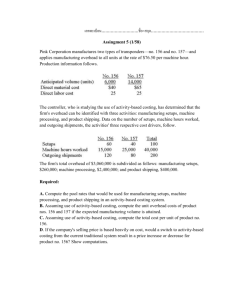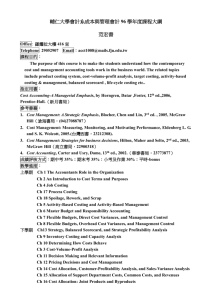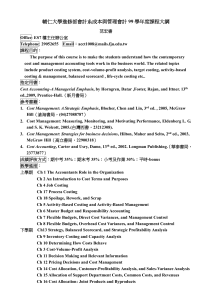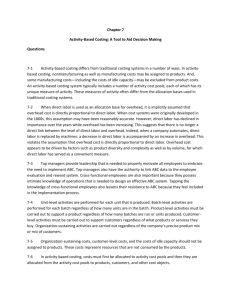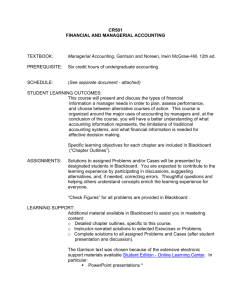M11-Chp-07-5-Activity Based Costing Concepts
advertisement
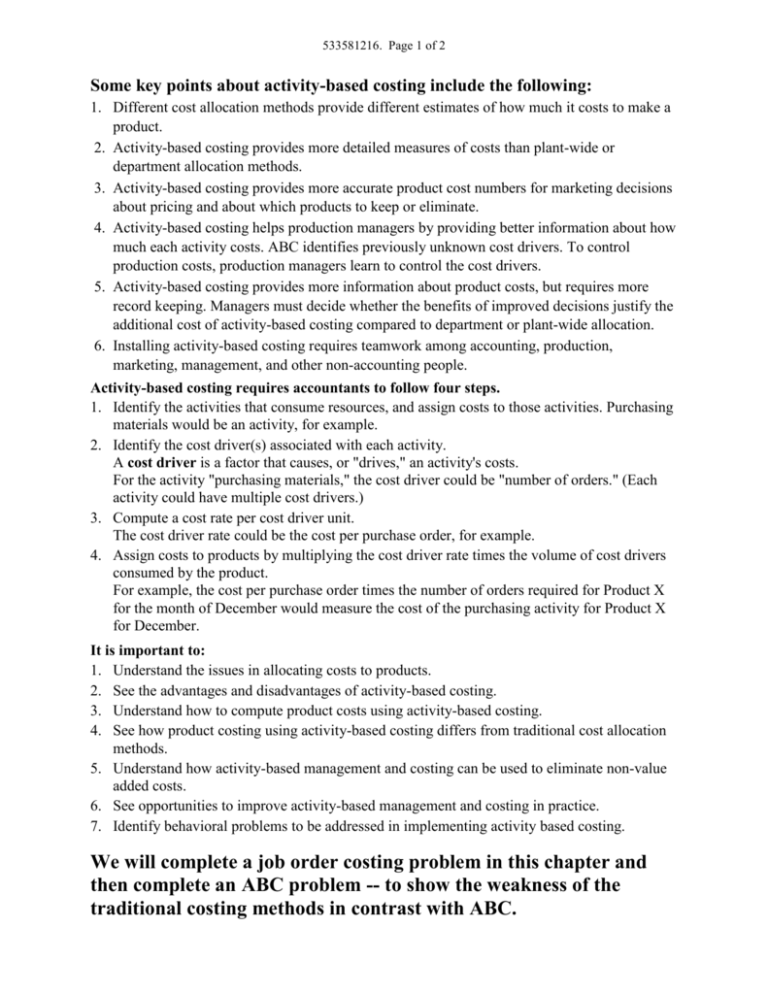
533581216. Page 1 of 2 Some key points about activity-based costing include the following: 1. Different cost allocation methods provide different estimates of how much it costs to make a product. 2. Activity-based costing provides more detailed measures of costs than plant-wide or department allocation methods. 3. Activity-based costing provides more accurate product cost numbers for marketing decisions about pricing and about which products to keep or eliminate. 4. Activity-based costing helps production managers by providing better information about how much each activity costs. ABC identifies previously unknown cost drivers. To control production costs, production managers learn to control the cost drivers. 5. Activity-based costing provides more information about product costs, but requires more record keeping. Managers must decide whether the benefits of improved decisions justify the additional cost of activity-based costing compared to department or plant-wide allocation. 6. Installing activity-based costing requires teamwork among accounting, production, marketing, management, and other non-accounting people. Activity-based costing requires accountants to follow four steps. 1. Identify the activities that consume resources, and assign costs to those activities. Purchasing materials would be an activity, for example. 2. Identify the cost driver(s) associated with each activity. A cost driver is a factor that causes, or "drives," an activity's costs. For the activity "purchasing materials," the cost driver could be "number of orders." (Each activity could have multiple cost drivers.) 3. Compute a cost rate per cost driver unit. The cost driver rate could be the cost per purchase order, for example. 4. Assign costs to products by multiplying the cost driver rate times the volume of cost drivers consumed by the product. For example, the cost per purchase order times the number of orders required for Product X for the month of December would measure the cost of the purchasing activity for Product X for December. It is important to: 1. Understand the issues in allocating costs to products. 2. See the advantages and disadvantages of activity-based costing. 3. Understand how to compute product costs using activity-based costing. 4. See how product costing using activity-based costing differs from traditional cost allocation methods. 5. Understand how activity-based management and costing can be used to eliminate non-value added costs. 6. See opportunities to improve activity-based management and costing in practice. 7. Identify behavioral problems to be addressed in implementing activity based costing. We will complete a job order costing problem in this chapter and then complete an ABC problem -- to show the weakness of the traditional costing methods in contrast with ABC. 533581216. Page 2 of 2 An Example 1. Imagine you produce 100,000 gallons per month of vanilla ice cream and your friend produces 100,000 gallons per month of 39 different flavors of ice cream. 2. Your ice cream is sold only in one liter containers, while your friend sells ice cream in various sizes of containers. Your friend has more complicated ordering, storage, packing in containers, and product testing (one of the more desirable jobs, nevertheless). 3. Your friend has more machine setups, too. You can set the machinery to one setting to obtain the desired product quality and taste; your friend has to set the machines each time a new flavor is produced. Although both of you produce the same total volume of ice cream, you can easily imagine that your friend's overhead costs will be considerably higher. 4. In general, the number of cost drivers has increased as companies have become more highly automated and more complex. 5. Cost systems based on a simple direct labor basis for allocating costs are generally inadequate in all but the simplest production or selling enterprise. 6. Department allocation rates based on volume, like direct labor hours or machine hours, have naturally allocated costs to products proportional to volume. Often, a higher proportion of overhead costs are allocated to higher-volume products and a lower proportion of overhead costs are allocated to lower-volume products. 7. Low-volume products may be more specialized, requiring more drawings and specifications, and require more inspections. After installing activity-based costing, managers have generally found that lower volume specialty products should be allocated more overhead than previously assumed under traditional volume-based allocation methods. 8. Low-volume products often require more machine setups for a given level of production output because they are produced in smaller batches. In the ice cream example, one batch of 1,000 gallons of the low-volume 39th flavor might require as much overhead cost for machine setups, quality inspections, and purchase orders as one batch of 100,000 gallons of the highest-volume flavor. Further, the low-volume product adds complexity to the operation by disrupting the production flow of the high-volume items. 9. When overhead is applied based on the volume of output, high-volume products are allocated relatively more overhead than low-volume products. In a sense, high volume products "subsidize" low-volume products. The high costs of providing a large number of low-volume products are hidden by volume-based allocation methods. Many companies continue producing or selling products without realizing their cost.


